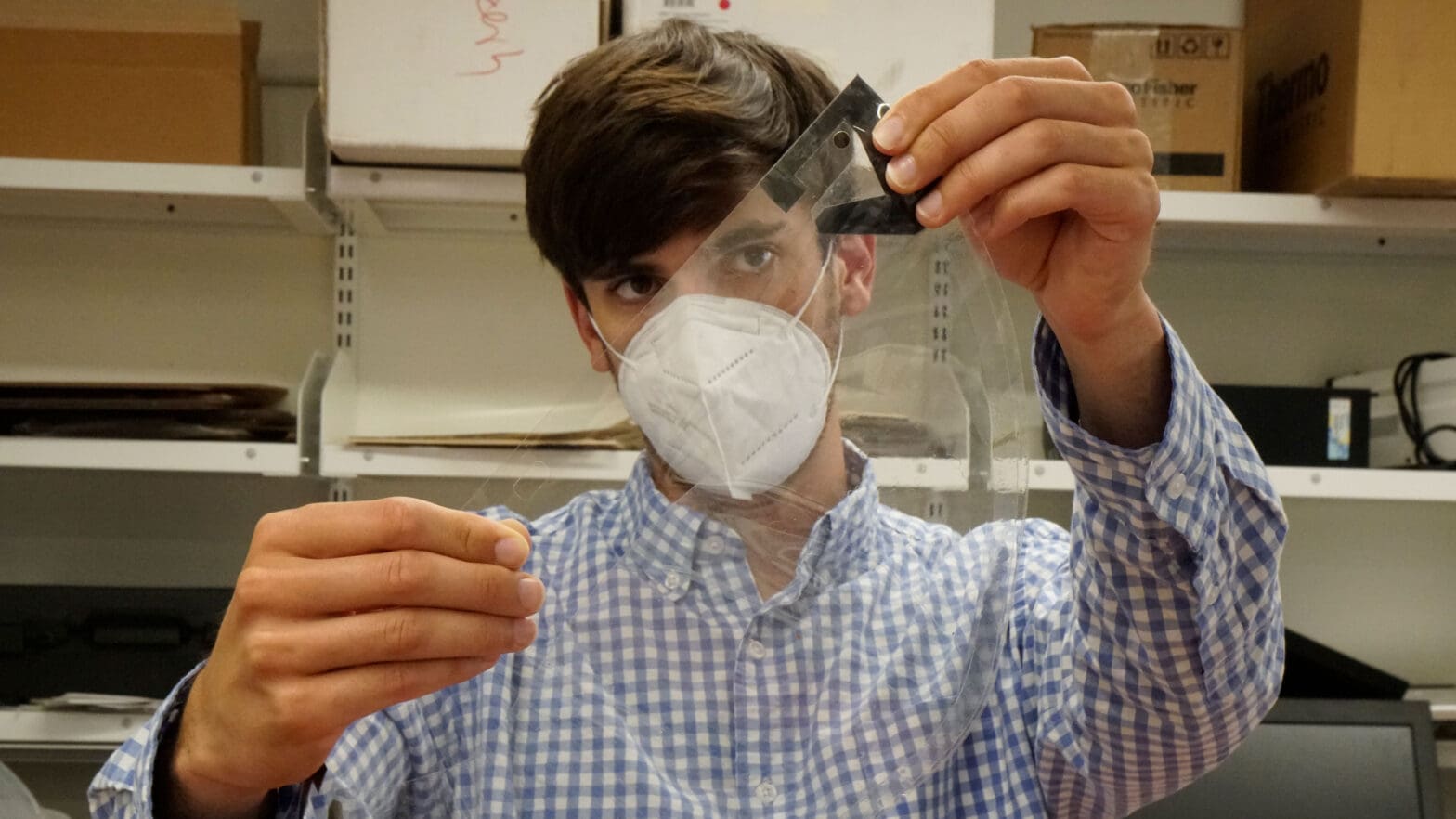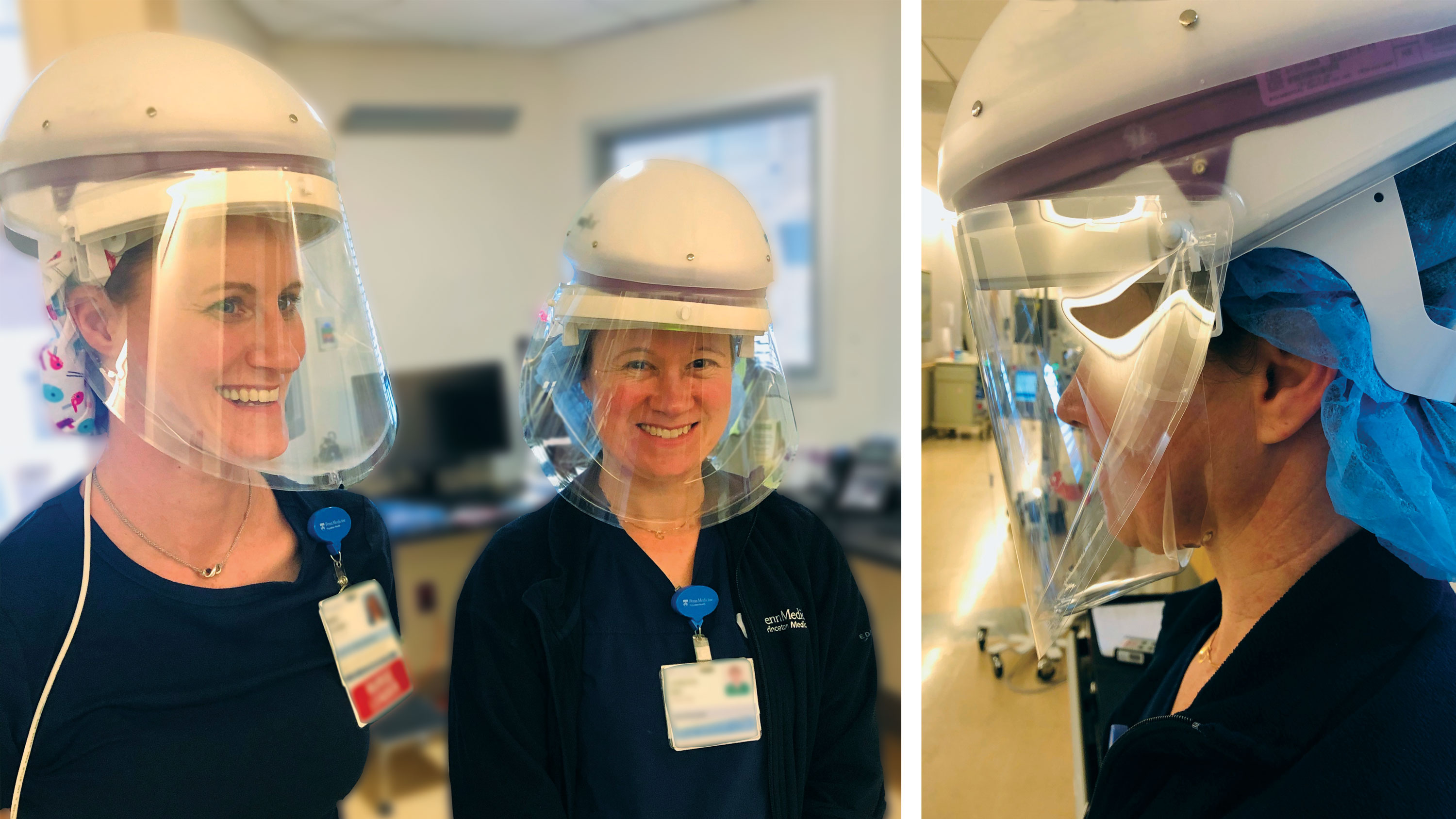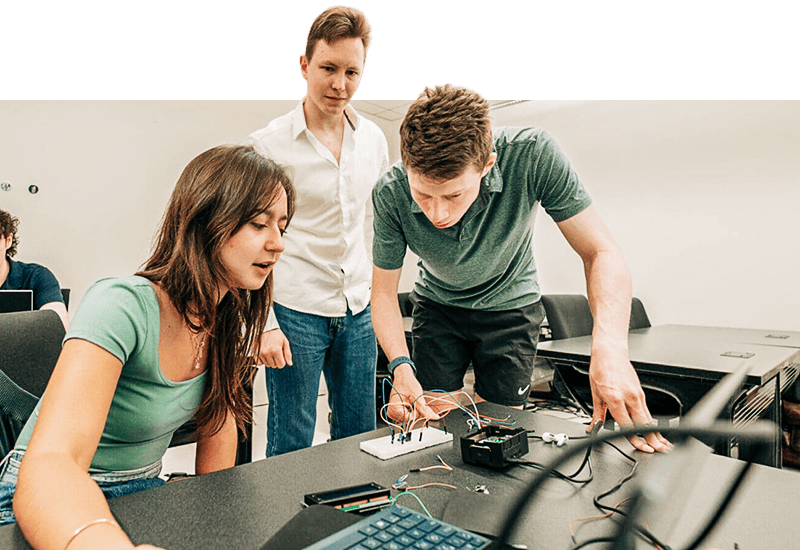
In pandemic, Princeton graduate students and faculty raced to create innovative protections for hospital staff
By
on
This is from the series COVID-19 Research and Service
Since then, University labs have delivered more than 3,000 reusable face shields to hospital staff in the emergency department and other areas of Penn Medicine Princeton Medical Center, as well as 1,500 specialized covers for the powered air purifying respirators (PAPRs) used by medical workers in high-risk environments. University labs recently received a request for another 1,000 PAPR covers.
In labs across campus, faculty, graduate students and research staff have been working to address urgent medical needs in the community — from producing the innovative face shields and other personal protective equipment (PPE) to developing several ventilator designs that are cheaper and more easily assembled than standard equipment.
Princeton faculty Daniel Cohen and Daniel Notterman assembled research groups from across academic departments to focus on the COVID-19 pandemic, pivoting from their usual research as they fielded calls from doctors and hospitals for assistance.
The PPE work was one of the early initiatives by the University to support efforts to combat the disease, in addition to ongoing COVID research regionally and internationally. Many of the research efforts began soon after the outbreak and continue today.
“I teach biomedical engineering and, like many people, I was looking for a way to help,” said Cohen, an assistant professor of mechanical and aerospace engineering. Cohen runs a seminar in which he connects engineering students and healthcare professionals interested in improving medical technology. Soon after the pandemic broke out, Cohen reached out to doctors and medical professionals to offer his team’s assistance.

When the pandemic hit, hospitals struggled to find enough personal protective equipment to meet their needs. At the request of administrators of Penn Medicine Princeton Medical Center, the hospital closest to the University, teams of Princeton students, faculty and postdoctoral fellows began creating face shields and then the more sophisticated “PAPR covers,” the pictured face-and-neck coverings that integrate with the powered air purifying respirators (PAPRs) needed for treating the most high-risk COVID-19 patients. Here, Princeton Medical Center nurses wear PAPRs with clear covers designed and built by Princetonians.
Photo courtesy of Penn Medicine Princeton Health
PAPR covers and face shields for frontline staff
Early on the morning of April 23, Cohen’s graduate student Matt Heinrich received an urgent text from administrators at Princeton Medical Center, in nearby Plainsboro, New Jersey.
The hospital needed stretchable, reusable, full-face-and-neck covers for the patient care units, and it needed them fast. Heinrich had just sent over a prototype he had made, and hospital administrators responded by asking for an immediate delivery.
Despite having had an adequate supply just days before, the hospital had seen such a sharp, sudden increase in the number of patients with COVID-19 that its supply of PAPR covers had dwindled to three.
“They said, ‘How many can you make?’” said Heinrich, a doctoral candidate in mechanical and aerospace engineering. “I said, ‘How many do you need?’”
The hospital asked for 10 immediately and another 10 in a few days. Heinrich delivered the first batch that afternoon. That night, his friend Thomas Schaffner, a 2018 graduate alumnus, stayed up to make another 10. Over the next few days, a network of volunteers sorted, cut and fastened parts for 100 more.
The team’s previous effort had focused on face shields, which look like clear plastic welder’s masks — a much simpler design than the PAPR covers the team was now making for the critical care unit.
The face shields’ design was not difficult, Cohen said. The challenge was finding available materials when everyone was scrambling for plastics used to make the face shields. The team was able to use alternate plastics similar to binder covers. They set up a system in which the purchasing departments at Princeton Medical Center and Robert Wood Johnson University Hospital obtained the material, and then team captains collected the parts and delivered them to volunteer assemblers. Six drivers supplied five assemblers, including a core group of volunteers from the Princeton Neuroscience Institute. Volunteers assembled the shields, then the captains picked up the finished devices and returned them for delivery. The entire process, reviewed by an ad-hoc committee on volunteer COVID-related activities in the Office of the Provost, allowed everyone to work safely, quickly and without need for close contact.
“We have delivered three to four thousand so far,” Cohen said.
A new design for PAPR covers
The PAPR project was much more complex. Medical workers in high-risk areas wear self-contained breathing systems called powered air purifying respirators. PAPRs are similar to full-face scuba masks and are much safer and better to use than standard face shields. To work, PAPRs must integrate seamlessly with an eye, nose and chin cover that has to be protective, flexible and elastically sealed from the neck up to the ears.
Kari Mastro, Ph.D., R.N., the director of practice, innovation and research at Princeton Medical Center and a key contact for the Princeton University team, had worked years before as an intensive care nurse with Notterman, a physician who is now a senior researcher and lecturer with rank of professor in molecular biology as well as the chair of Princeton’s Institutional Review Board for Human Subjects.
“Dan Notterman had reached out and said, ‘Princeton University has a whole engineering department willing to help if you have any needs,’” Mastro said. “We started to look at supplies, and the key critical ones such as face shields and PAPR covers — that might be something that they could work on.”
Mastro said that obtaining enough PAPR covers was particularly challenging because they are relatively complex and meant for single use only. Used mainly in surgery and high-risk procedures, the equipment has been in high demand during the pandemic and very difficult to obtain.
Heinrich said: “I was on a call with the Princeton hospital administration, and they mentioned, ‘If you could make a replacement part for the PAPRs, that would be amazing.’”
Each PAPR cover has a clear plastic visor and a fully-bonded, stretchable membrane that seals all around the wearer’s face. Cohen’s team took about a week to replicate the design with fully reusable and available parts, including materials already in their lab.
“We buy silicone for the lab, and it turns out the silicone is shipped between protective plastic sheets that are the same kind of plastic used in the visors,” Cohen said. “As this material by itself was in extremely short supply across the world at this point, we used the packaging plastic for the visors and we turned the silicone into the bonded face-and-neck gaskets.”
The team sent their prototype to the hospital, which prompted the early-morning text asking Heinrich for as many as he could produce.
Working with re-purposed craft cutting machines, Heinrich and Cohen created the components of the PAPR covers that they shipped to teams of volunteer assemblers. Eventually, Cohen said, they sent the design to their suppliers. The supplier pre-cut the pieces and returned them for assembly at Princeton, where over 1,500 have now been assembled. The PAPR cover design not only met the hospital’s needs but it proved more durable than the standard cover, Mastro said.
The Princeton team shared their design so the PAPR covers could be replicated for the entire Penn Medicine system, which operates in New Jersey and Pennsylvania. Cohen’s group is now filling a request for 1,000 more PAPR covers from Princeton Medical Center to meet the recent increase in COVID cases.
“The doctors and nurses who trialed the PAPR covers designed by Matt and Dan felt they were fantastic, so we have asked the team at Princeton University to support us again,” said Mastro. “The supply of PPE across the country is stressed as we enter the winter months and COVID-19 cases continue to rise. We have enough PPE to ensure the safety of our team here at Penn Medicine Princeton Health right now, but we want to be sure we remain prepared.”
For Cohen and his team, the effort has not only been a chance to serve the community but also to work with colleagues across the University and beyond in a new way.
“Very early on, when we just started getting calls from doctors and hospitals, I asked [MAE postdoctoral research fellow] Tom Zajdel how he was approaching the idea of spending weeks on projects that had nothing to do with our research,” Heinrich said. “He said all the research data would still be there, but the opportunity to help would not.”







